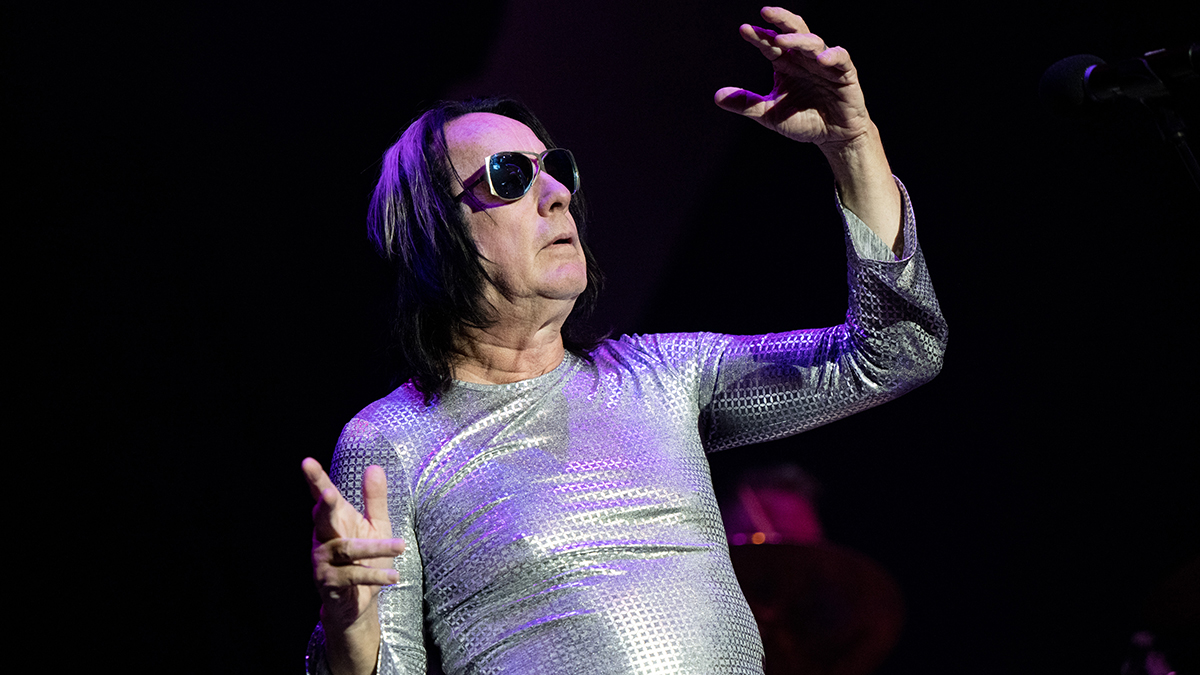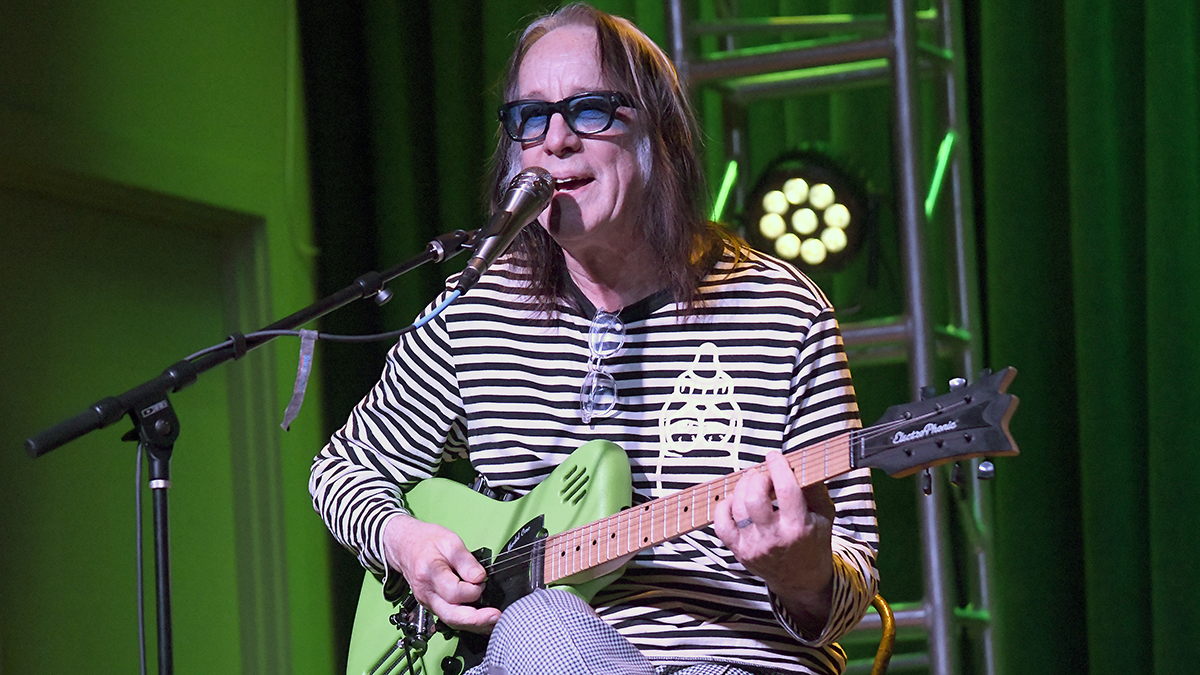“I have yet to be convinced by any song that AI has come up with. Everything sounds like Taylor frickin’ Swift!”: Todd Rundgren on music, microdosing, accidentally creating hit records and why he ditched Pro Tools
“I like to keep busy,” says the legendary artist and producer

“For a while back there in the ‘70s, drugs seemed to work for me,” laughs Todd Rundgren. “It’s strange really because, up until the age of 21, I had completely avoided drugs and alcohol. Drugs and beer turned musicians into morons, so I figured I’d be the one to stay sober.
“Then, a med student friend introduced me to cannabis... and a guy dropped off a shoebox full of peyote tabs. I wasn’t taking these things to escape from life, I took them because they helped me understand how my brain worked. I seemed to be more effective, I could understand why my mind was constantly leaping from this idea to this idea. Problems became easier to solve because I could see them in the distance before they arrived. I was already prepared.
“Today, I suppose you’d call it microdosing. I was just getting to the point where things were starting to happen but life around me went on as normal. I gigged, I rehearsed, I wrote and recorded; I even managed to rewire part of the studio I was working in. Having said that, some of the music I made at the time was quite experimental.”
It’s tempting to call Todd Rundgren’s entire career – almost 60 years’ worth of recording, producing, engineering and playing live – an “experiment”. Albeit one that the man himself was always in control of. Along with the likes of Brian Wilson, Zappa, Sparks, Beefheart and Eno, Rundgren has that rare compulsion (some might call it a deep psychological need) to follow his creative heart, no matter where it leads.
As you’d expect, then, his studio CV is diverse in the extreme: The Tubes, New York Dolls, XTC, Sparks, Patti Smith, The Band, Van Morrison, Hall & Oates, Grand Funk Railroad. Then there’s the no-small matter of his solo/band/side-project/live output which has to be somewhere around the 50 albums mark.
“I like to keep busy,” is all he says when quizzed about his relentless work rate.
Unsurprisingly, the project he gets asked most about is Bat Out of Hell. Depending on which account you read, Rundgren produced, mixed, played guitar and even financed the album, but one thing is certain: his maverick talent helped shape one of the best-selling albums of all time.
Want all the hottest music and gear news, reviews, deals, features and more, direct to your inbox? Sign up here.
Although Jim Steinman was the album’s composer and musical mastermind, he gave Rundgren free rein in the control room. Indeed, Steinman later referred to Rundgren as, “the only genuine genius I have ever worked with”.
“I don’t generally respond well to people peering over my shoulder,” he says, smiling broadly. “Sure, the recording process was hard work, but when it came to taking a first pass at the mix, I didn’t want anyone at the console with me. If Jim or the band had been present for that process, it would have become a battle for more volume, with all the faders ending up at the top. I did my pass, then called the band in so they could listen with fresh ears. I took a few notes, listened to their concerns, did another pass and so on.
“Jimmy Iovine [producer for Springsteen, Tom Petty, Lennon, Dire Straits et al] was brought in for another go at the mix and they may have hectored him like crazy, I don’t know. Never happened with me.”
Rundgren was still in his 20s when Bat Out of Hell was released, but he already had a decade’s worth of production under his belt. After splitting from his garage pop/rock band Nazz, in 1969, 21-year-old Todd was brought in as “house engineer” at Albert Grossman’s Bearsville Studio in Woodstock.
“Albert [Grossman, who looked after a lot of the era’s folkier superstars like Peter, Paul and Mary, Richie Havens and Bob Dylan] wanted me to update the slightly tired sound of some of his acts,” he explains. “I was the kid who knew his way around all this up-to-date technology. We’d gone from four-track to eight to 16... more sophisticated reverbs and EQ units. Consoles changed, too; suddenly, you’d got all this freedom to play around with sound.”

Even though he was working with some big name acts and getting paid handsomely for his time, there was little chance that Rundgren was content to be no more than a hired gun. He released his first “solo” album, Runt in 1970 [Rundgren was joined by Hunt Sales on drums and Tony Fox Sales on bass] and hasn’t really stopped.
The output has varied from intense blasts of jazz-metal to cocktail electronica, from gorgeous cover versions to bona fide mainstream pop ditties. And even chart hits! It’s tempting to wonder whether Rundgren – ever the contrarian – gets ever so slightly miffed when he releases a successful single like Hello, It’s Me, which made the US Top 5.
He thinks hard about his answer. “Look, hits can be remarkably enabling, especially if you can string together a bunch of them. But you can’t always calculate what a ‘hit’ is before it becomes one and if you fail to penetrate the market, you may just wind up with a stinker on your hands.
“In my solo career, I never set out to have a hit and I was always surprised when I wound up on the charts. I’m not a genre artist, but every once in a while I will accidentally capture the zeitgeist. I suppose the problem arises when no one wants to hear anything else you have to say but the hits.”
Having always kept pace with the ever-changing technology available to musicians, it’s no surprise to see Rundgren waving around his laptop when I ask him where his studio is these days.
“It’s in here. I’ve been using Reason for about 20 years. I got fed up with Pro Tools when they were acquired by Avid and started making the transition when Reason was only an instrument sequencer. The app has evolved into a serious DAW and I haven’t had a ‘reason’ to adopt anything else.
“Apart from that, I don’t have a lot of external equipment. I’ve had a longstanding relationship with Eventide, so I have their latest boxes. Most of the hardware I used to use has become virtualized. I don’t need to impress anyone with all my vintage gear.”
No problem with digital sound, then?
“Of course not. There are those who still insist on a pure analogue signal path, but that doesn’t make any sense to me. In the end, virtually no one is hearing uncompressed analogue sound. Antique gear is like antique cars in that most of them are high-maintenance and will sit in the garage undriven for fear of compromising their value.
“Digital has offered the democratising power of affordability and availability. Why shouldn’t non-professionals and startups have access to the features of otherwise unaffordable gear? Most VSTs can run at the maximum sample rates, so only a crank would complain about their virtuality.
“We also now have democratisation of distribution, too. You don’t need to jump through all those hoops to get your music out there. If you have talent, you can let people know about it. The problem is that you’re also competing against everything else that’s out there on the internet. A great song might struggle to get a hundred thousand hits, but you’ve got some influencer eating a teaspoon of cinnamon and getting 10 million hits.’
So, technology isn’t the problem... it’s how we use it? What about AI?
“I have no problem using AI to help me in the studio. I can deconstruct an old recording and turn it into separate stems... retune the vocal. But getting AI to write music? I have yet to be convinced by any song that AI has come up with. Everything sounds like Taylor frickin’ Swift!’”
Todd Rundgren is currently touring the UK and plays the Sub Rooms, Stroud (27 October), the Alexandra, Birmingham (28 October), and London Palladium (29 October) this month. Runt [Early Alternate Version] + Bonus 7” is on Rhino Red Vinyl.
You must confirm your public display name before commenting
Please logout and then login again, you will then be prompted to enter your display name.
